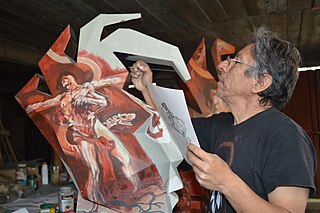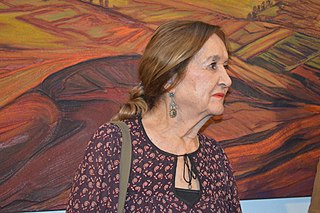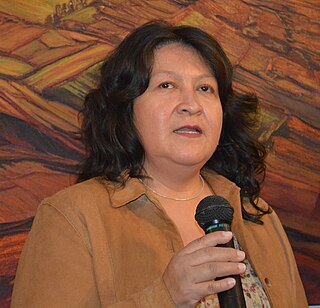Related Research Articles

Arturo García Bustos was a Mexican painter and print maker. He is known as one of “Los Fridos” students who studied under Frida Kahlo at her home in Coyoacán.
Fanny Rabel, born Fanny Rabinovich, was a Polish-born Mexican artist who is considered to be the first modern female muralist and one of the youngest associated with the Mexican muralism of the early to mid 20th century. She and her family arrived to Mexico in 1938 from Europe and she studied art at the Escuela Nacional de Pintura, Escultura y Grabado "La Esmeralda", where she met and became friends with Frida Kahlo. She became the only female member of “Los Fridos” a group of students under Kahlo’s tutelage. She also worked as an assistant and apprentice to Diego Rivera and David Alfaro Siqueiros, painting a number of murals of her own during her career. The most significant of these is "Ronda en el tiempo" at the Museo Nacional de Antropología in Mexico City. She also created canvases and other works, with children often featured in her work, and was one of the first of her generation to work with ecological themes in a series of works begun in 1979.
Herminio Feliciano Peña Aguilera was a Mexican painter and engraver. His work was recognized with membership in the Salón de la Plástica Mexicana and was a founding member of the Sociedad Mexicana de Grabadores.

Julio Carrasco Bretón is a Mexican artist mostly dedicated to murals and canvas work. He invented a technique for creating murals which allows him to create panels in his workshop, and then stack them for transport to the assembly site. His educational background is in science and philosophy as well as art and the themes in his work, especially murals often reflect these themes. In addition to creating art, he has been active in cultural, artistic and copyright issues, involved in the founding of a number of organizations and involved in others additionally.

Antonio García Vega is a Mexican artist and member of the Salón de la Plástica Mexicana. He began exhibiting his work while still in school in the early 1970s and continues to do so, often working with his brother Mauricio García Vega. He works in mixed media to paint various forms of expression. His early work was mostly fantastic, with elements of eroticism but his later work has been darker as a means of expressing his own feelings and moods. His work has mostly been exhibited in Mexico, often in conjunction with other artists including a 2010 exhibition with his brother at various venues.

Deyanira África González Melo is a Mexican sculptor who generally works in ceramics, depicting elements of the human form, especially the torso, generally with mutilations and other disturbing elements to dispute the otherwise traditional and sensual depictions of the human body. She has exhibited her work since studying at the Escuela Nacional de Artes Plásticas (ENAP) in Mexico as well as in Europe and the Caribbean. Her work has received recognition in Mexico and abroad, and is a member of the Salón de la Plástica Mexicana.
Andrea Gómez y Mendoza was a Mexican graphic artist and muralist, a member of the Salón de la Plástica Mexicana.

Rina Lazo Wasem was a Guatemalan-Mexican painter. She began her career in mural painting with Diego Rivera as his assistant. She worked with him from 1947 until his death in 1957 on projects both in Mexico and Guatemala. Thereafter, she remained an active painter, better known for her mural works than canvases, although the latter have been exhibited in Mexico and other countries. This has made her one of Guatemala's best-known artists. She was a member of the Mexican muralism movement and criticized modern artists as too commercial and not committed to social causes. She believed muralism would revive in Mexico because of its historical value.

Vicente Gandía was a Mexican artist of Spanish origin who is best known for his depictions of nature and buildings. He originally trained to be an architect but abandoned this in favor of art, but with his art career beginning by drawing interiors. His major break came in 1968, with international expose which led to greater demand for his work. Recognitions for his art include membership in the Salón de la Plástica Mexicana, two awards from the same institution, a homage to the artist sponsored by the Instituto Nacional de Antropología e Historia while still alive and two others after his death, one with the Festival Internacional Cervantino.

Herlinda Sánchez Laurel was a Mexican artist and art professor at the Universidad Nacional Autónoma de México. Her career has been recognized by membership in the Salón de la Plástica Mexicana, and awards from the state of Baja California, the Palacio de Bellas Artes and the International Coordination of Women in Art among others.
Valetta Swann was an English painter and sculptor, known for her work related to rural and indigenous life in Mexico and the United States. She began her art career in Europe, but moved to the United States with her husband, anthropologist Bronisław Malinowski. Swann collaborated with him on drawings and photographs of indigenous life there and in Mexico. Malinowski died in 1942, and Swann decided to live permanently in Mexico City, having her first individual exhibition at the Palacio de Bellas Artes in 1945. She had more than fifty individual exhibitions of her work in Mexico, the United States and Europe and her work was recognized with membership in Mexico's Salón de la Plástica Mexicana.
Beatriz Zamora is a Mexican artist who is best known for her monochrome works in black. Although she has struggled commercially, her work has been recognized at various points in her career such as with membership in the Legion of Honor of the Académie des Beaux-Arts in France and the Sistema Nacional de Creadores de Arte in Mexico.

Chappie Angulo is an American-Mexican painter and illustrator whose work has been recognized with membership in Mexico’s Salón de la Plástica Mexicana.
Yolanda Cabrera is a Mexican artist who was a graphic designer for twenty years before turning to the fine arts. Her work shows influence from her former profession along with the use of personal symbolism and experimentation in both materials and techniques. Cabrera’s work has been shown regularly in Mexico City and other parts of the country and has been recognized by the Salón de la Plástica Mexicana.

Angelica Carrasco is a Mexican graphic artist who is a pioneer of large scale printmaking in the country. Her work often is related to violence and classified as “abstract neo-expressionism.” Much of her career has been dedicated to teaching and the promotion of the arts, especially the graphic arts and has been recognized with membership in the Salón de la Plástica Mexicana and the Sistema Nacional de Creadores de Arte.

María Eugenia Chellet is a Mexican artist who has evolved from photography to mixed media and currently focuses mostly on performance. Her work focuses on exploring female archetypes and other images relating to femininity, often using herself in roles such as female Biblical figures, those in classical artwork and those from commercial mass media of the 20th century to the present. Her work has been recognized with membership in the Salón de la Plástica Mexicana.
Laura Elenes (1933–2005) was a Mexican painter, sculptor and print maker. whose work was recognized with membership in the Salón de la Plástica Mexicana and several tributes in Mexico and other countries after her death.
Tania Janco is a Czech and Mexican artist, known for her painting and print work, especially in the illustration of children's books. Her work has been recognized the Caravelle D’ora Prize in Italy and membership in the Salón de la Plástica Mexicana.
Rosa Lie Johansson was a Swedish-Mexican painter whose work was recognized with membership in the Salón de la Plástica Mexicana.
Noemí Ramírez is a Mexican visual artist, whose work has been recognized with several honors including membership in the Salón de la Plástica Mexicana.
References
- 1 2 3 4 5 6 7 8 9 10 11 12 13 Mujeres del Salón de la Plástica Mexicana. Vol. 1. Mexico City: CONACULTA/INBA. 2014. pp. 72–73. ISBN 978-607-605-255-6.
- 1 2 3 4 5 6 7 "Myriam de la Riva". Sociedad Mexicana de Autores de las Artes Plásticas. Archived from the original on January 24, 2008. Retrieved March 21, 2015.
- 1 2 3 4 5 Xavier Rosado (August 26, 2002). "El color es vida y con él Myriam de la Riva descubre el alma de las cosas". El Sur. Acapulco. Archived from the original on April 3, 2015. Retrieved March 21, 2015.
- 1 2 3 4 "Compartirá Myriam de la Riva su "Poesía urbana. exilios". Abrirá muestra en el Salón de la Plástica Mexicana". NOTIMEX. Mexico City. September 22, 2002.